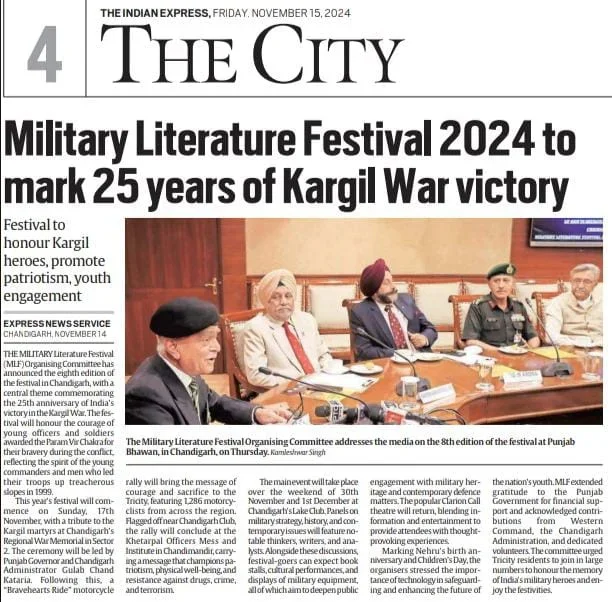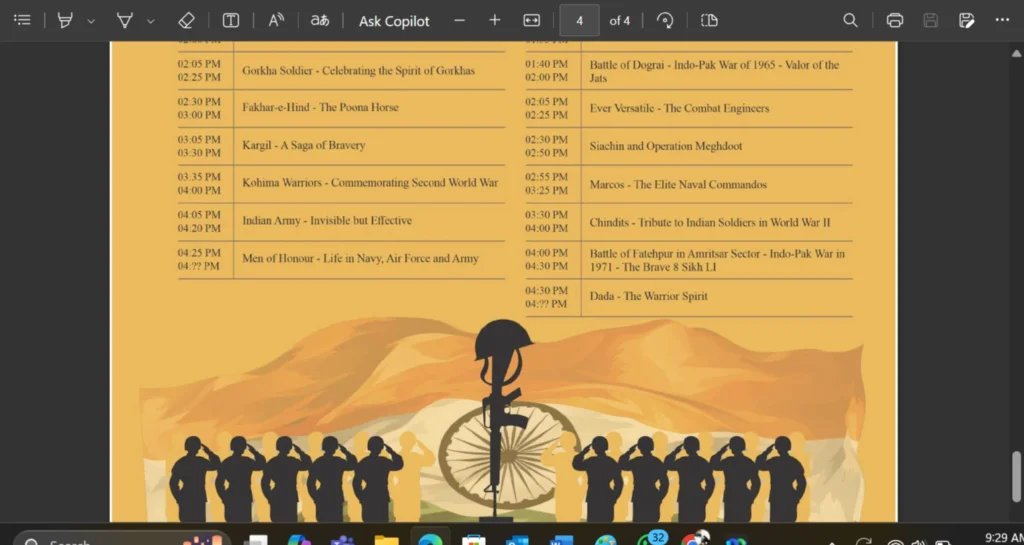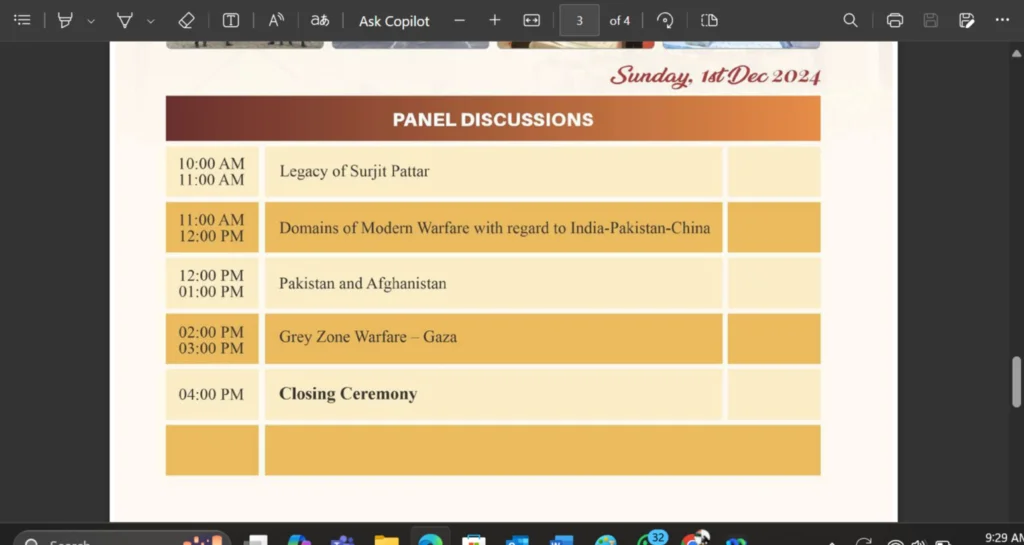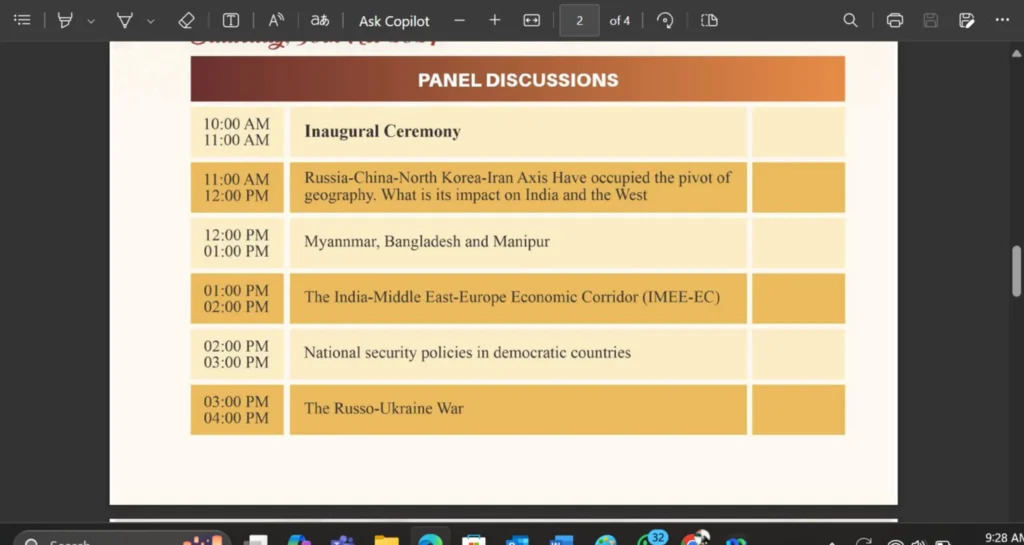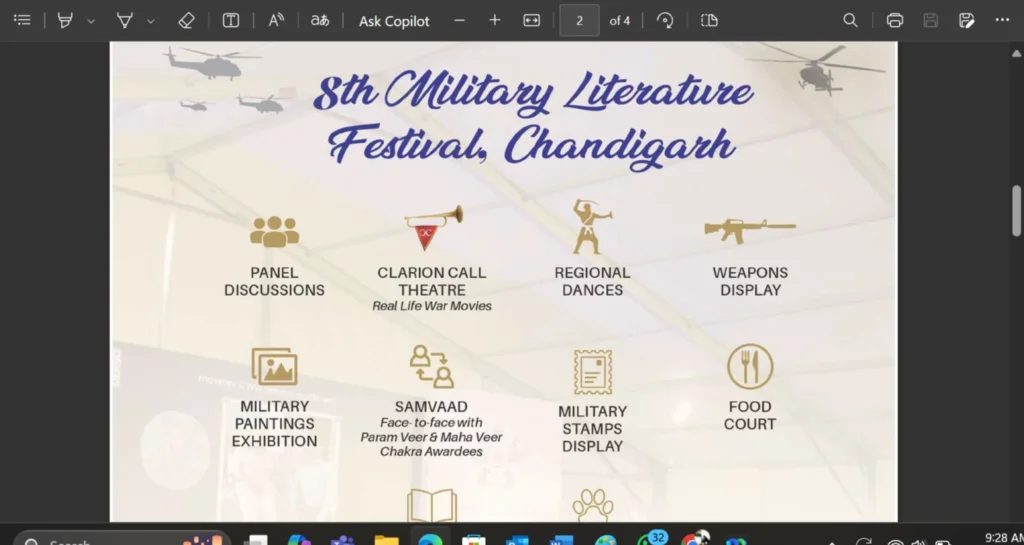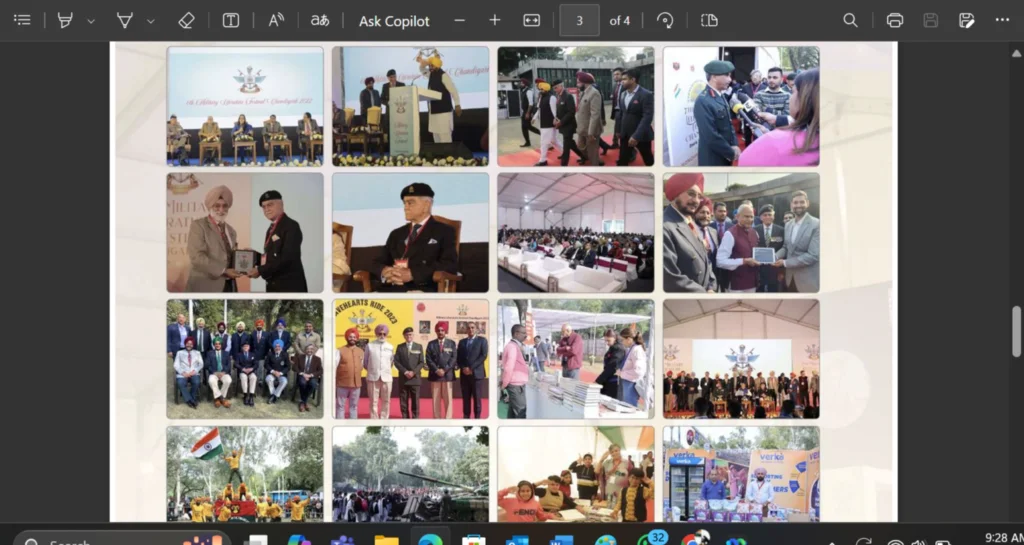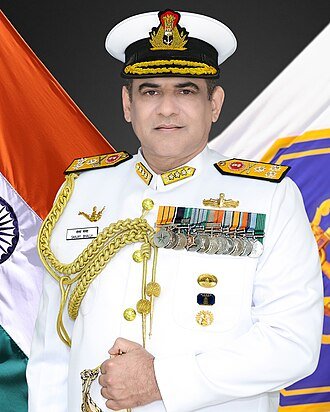
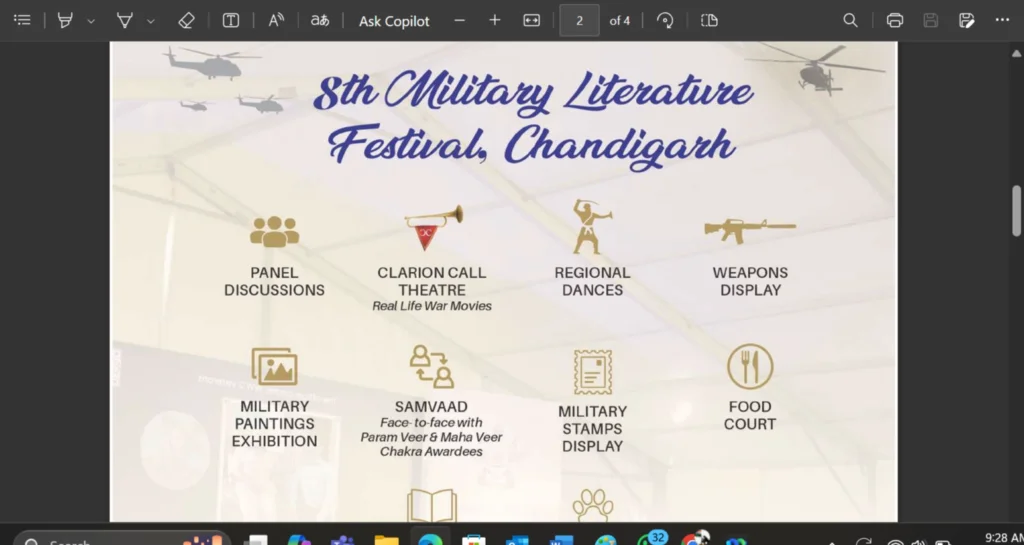

















The Indian Army has decided to permit tourists to visit icy heights of Siachen Glacier, Kargil and also the Galwan Valley to enable them to get first-hand experience of these inhospitable battlefields, Chief of Army Staff (COAS) General Upendra Dwivedi…

The Indian Army has decided to permit tourists to visit icy heights of Siachen Glacier, Kargil and also the Galwan Valley to enable them to get first-hand experience of these inhospitable battlefields, Chief of Army Staff (COAS) General Upendra Dwivedi said on Wednesday.
He asserted the dominant theme in Jammu and Kashmir has changed from “terrorism to tourism” and added the Army has facilitated this transformation.
General Dwivedi was delivering a lecture on the topic, ‘Role and Contribution of Indian Army in Securing India’s Growth Story’, under General BC Joshi Memorial Lecture Series, organised by the Department of Defence & Strategic Studies (DDSS) of the Savitribai Phule Pune University.
The COAS said Jammu and Kashmir, where a new government took office last month after Assembly polls, has immense potential in the tourism sector.
“Transformative potential of tourism is immense and an exponential rise (in travellers visiting J&K) has been seen in recent times. Forty-eight areas have been identified for promoting tourism. With targeted initiative, we have the potential to double our tourist numbers in the next five years,” the Army chief noted.
The Army is committed to promote adventure activities and provide special training to tour organisers and operators to enhance footfalls in border areas, he said.
“Upskilling locals in mountaineering and associated activities are part of our training programme, which includes Trans-Himalayan trek, ‘Soul of Steel’ trek in Uttarakhand and opening of trek to Siachen Glacier for all citizens.
“We are also opening battlefields, including Kargil and Galwan, for tourists to allow them to get first- hand experience of such battlefields,” General Dwivedi maintained.
The Siachen Glacier, located in the Karakoram mountain range of Ladakh, is known as the world’s highest and coldest battlefield. Kargil, a district in the Union Territory of Ladakh, was the site of the 1999 India-Pakistan war.
The Galwan river valley in Ladakh saw a deadly clash between Indian and Chinese troops in June 2020.
The High Court of Jammu & Kashmir and Ladakh has dismissed the petition of a senior Indian Air Force (IAF) officer who had sought quashing of an FIR lodged by the J&K Police following a complaint by a fellow woman…


The High Court of Jammu & Kashmir and Ladakh has dismissed the petition of a senior Indian Air Force (IAF) officer who had sought quashing of an FIR lodged by the J&K Police following a complaint by a fellow woman officer alleging sexual assault, harassment and mental torture.
The FIR was lodged in September under Section 376(2) of the IPC at Budgam police station on the woman Flying Officer’s allegation against the Wing Commander posted in Srinagar, whom the HC had granted pre-arrest bail.
Victim’s counsel Advocate Ayshia Shakeel Zahgeer said the petition filed by the accused before the High Court seeking quashing of the FIR was dismissed. The court announced the judgment on Wednesday. The HC had earlier heard the arguments and reserved its decision. “The court stated that the internal committee has given an inconclusive finding and the same cannot be said to be exoneration from the offence and that the police have unfettered powers to investigate a cognizable offence in terms of the code of criminal procedure. The court therefore said it was not inclined to exercise its inherent powers and rejected the petition,” she said.
The court also quashed the orders of the Chief Judicial Magistrate (CJM), who in its first order allowed the IAF to take over the investigation and days later withdrew its order. Invoking Air Force Act, 1950, the IAF last month had approached a court in Budgam and subsequently, the CJM, Budgam, in its first order said that “Incharge, Police Station, Budgam, shall stop further investigation in the matter and hand over all the case papers to the competent authority for enabling them to investigate the matter as per Air Force Act, 1950 and court martial the accused.”
Section 124 of the Air Force Act, 1950, gives a choice between “criminal court and court-martial.” However, days later, the CJM recalled its own order and issued a show-cause notice to the IAF officer to “explain as to why he suppressed the material facts before the court.”
The Union of India, however, approached the HC, challenging the order of the Chief Judicial Magistrate, Budgam. The High Court, meanwhile, stayed both the orders.
Advocate Ayshia said the High Court in its judgment quashed both the orders of CJM, Budgam, that were challenged in a connected petition filed by the Air Force.In its judgment, the court has also said that IAF will have liberty to file a fresh application before the court under Section 124 of the Air Force Act after the filing of chargesheet in the case.
Advocate Zahid Qais Noor, one of the counsels in the case, said the court asked police to file the chargesheet in the case. “Bail matter has been listed separately,” he said. The J&K Police had registered a case after a woman officer alleged that after a party at the Air Force Station in Srinagar on the New Year’s Eve last year, a Wing Commander took her to his room on the pretext of handing her over some gift and sexually assaulted her.
Amid a rise in terror activities in Jammu division, the Union Ministry of Home Affairs (MHA) has deployed National Security Guard (NSG) commandos in Jammu to act swiftly in case of terror attacks. A team of the NSG has been…

Amid a rise in terror activities in Jammu division, the Union Ministry of Home Affairs (MHA) has deployed National Security Guard (NSG) commandos in Jammu to act swiftly in case of terror attacks.
A team of the NSG has been stationed in the city as the force specialises in dealing with the terror threat to sensitive areas and installations, especially public places. While the sources did not disclose the strength and precise location where the team will be stationed, it has been learnt that they will be airlifted in case of exigency to reach the destination within minutes.
The hub of the NSG has been created in Jammu following multiple attacks in the region in the recent past. Highly trained terrorists have been able to infiltrate into the Jammu region who have attacked and killed many security personnel during the past two years. Many of these ultras are armed with M-4 carbines with night vision and thermal imaging devices that has come as a surprise to the intelligence agencies.
The NSG team has however been deployed to take care of security within Jammu city area that has multiple hotels, malls and other public places guarded by only private security. It has been learnt that some of these installations have already been audited and measures have been put in place for strengthened security.
The terrorists in the recent past have used the tactics of ambush in forest areas and ‘hit and run’ where they escape after attacking the security forces in deep jungles. There have been incidents where the ultras have cleverly ambushed the search parties inside the forest areas of the region. Most of the districts in the region, including Kathua, Jammu, Udhampur, Rajouri, Poonch, Reasi, Doda and Kishtwar, have witnessed spike in terror activities in the recent past.
Interestingly, present Director General of Police (DGP) Nalin Prabhat was serving as the chief of NSG till August when his tenure was cut short and he was sent to Jammu and Kashmir to deal with the rising terror incidents in the UT. Earlier, NSG commandos were airlifted from Delhi or Chandigarh in case of any emergency in J&K.
THis is the taunting remark made by the then UK Defence Secretary Ben Wallace on February 23, 2022, even before Russia had invaded Ukraine: “The Scots Guards kicked backside of Tsar Nicholas-I in 1853 in Crimea and we can always…


THis is the taunting remark made by the then UK Defence Secretary Ben Wallace on February 23, 2022, even before Russia had invaded Ukraine: “The Scots Guards kicked backside of Tsar Nicholas-I in 1853 in Crimea and we can always do it again.” He was referring to the 170-year-old Crimean War between Moscow and the tripartite forces of London, Paris and Ankara’s Ottoman Empire which defeated Russia to conclude with the Treaty of Paris in 1856. The palpable hatred of the West’s Anglo-Saxon people towards Russia is unmistakable.
Fast forward one month, to March 22, 2022, and one finds Joe Biden, President of the US (POTUS), blurting out another verbal bullet in Warsaw: “For God’s sake, this man Putin cannot remain in power.”
What message was POTUS giving to the world? Was he in charge of the regime change of Moscow and judge, jury and arbitrator, with powers of the world supercop on the prowl? Or, was he heading the sole superpower state? For a minute, however, POTUS acted like a non-state actor of a tinpot dictatorship!
True, Biden was referring to the wrong and illegal Russian invasion of the sovereign Ukraine. But, did he remember the plethora of worse wrongdoings of his own country committed in the 21st century? Again, it’s true that two wrongs cannot make one right, yet one has to be rational, restrained and reticent while uttering words to make a point on an international platform dealing with such crisis situations as the Russia-Ukraine conflict.
Russia was wrong on all counts to invade Ukraine on February 24, 2022, and under no stretch of the imagination can the Moscow aggression be defended. It’s a naked 18th -20th century imperial-type aggression by the powerful to conquer the weak. Moscow had no business to trample upon Ukraine’s sovereignty.
Nevertheless, on closer scrutiny, it is seen that the Russian invasion of Ukraine was born of a ceaseless two-decade-plus shameless US-led NATO and EU provocation, which posed a dire and direct existential threat to Moscow’s geography through her underbelly of Kiev.
Hence, despite Russian President Vladimir Putin being wrong, he had reason to be wrong, and reason to be not right. It’s the blatant West-plotted expansion towards the East that Russia couldn’t have ignored beyond a point. All the more so because the once-sovereign USSR had already been broken into 15 states in December 1991, with Russia being one of the new states.
The shrunkened and weakened Russia, thus, constituted a fresh opportunity for the traditional imperialist powers of the West to get back to their favourite pastime: Of expanding territory, controlling resources and subjugating local manpower to subservience to bolster their own economy and multiply their growth chart, the way it zoomed from the 17th to the 20th century.
Today, the Russia-Ukraine war is more than a local conflict of the Balkan-Black Sea belt. The outgoing POTUS, Biden, has suddenly escalated the war, which could be potentially disastrous for Europe if it remains just a conventional conflict. However, in the unlikely event of the use of nuclear wares, one cannot predict the conflict’s outcome.
Indeed, whatever the future course of the Ukraine war, Biden (the Anglo-Saxon who hates Russia), for sure, will go down as a would-have-been hero who fell as a tragic villain in the history of the USA in general and the history of European warfare in particular for escalating the war zone into a potential Armageddon.
Ironically, the villain should have been Putin for initiating the war. But the role has been diametrically reversed as Biden seems to have taken over the mayhem mantle from the Moscow man.
Thus, Biden has perfectly fitted into Putin’s shoes by allowing US-made lethal weapons to be targeted deep into Moscow’s land. Obviously, Moscow will react and go for reprisals on the source of the weapons’ launch pads.
And the launch pads may be any country, but certainly not the US or the UK, the two Anglo-Saxon nations whose hatred for the eastern state of Russia constitutes permanent chapters of world history.
Where, then, do things go from here? The biggest puzzle at this point in time to the world in general and the West in particular is US president-designate Donald Trump, whose dislike for Biden is too conspicuous to be ignored.
Biden inherited the Trump legacy of the Afghan war end-game. And August 2021 is a bad dream come true for the new POTUS. The retreat after the 20-year war made Biden a bitter man. The October 2024 escalation of the present Ukraine war is the right punch for Biden to deliver as a revenge trophy to Trump, his 2021-predecessor-cum-2025-successor.
The short of the long story, therefore, is the revival of Anglo-Saxon versus Russia rivalry on the fringe of Europe. The imperial sea powers of the West would prefer to continue with the proxy conventional war in land owing to their inherent discomfiture to take a direct fight with a monstrous land power which has traditionally thrived on protracted conflict away from the water. The Anglo-Saxons may like to think that the long war on land would weaken the Slav Russia both economically and demographically, but that may not turn out to be so.
The dynamics of political alignments are changing rather fast, with land powers uniting to take on the comparatively smaller sea powers with diminishing demography and challenging economy.
In fact, that’s the reason the Anglo-Saxons are emphatically propounding the importance of long-range high-tech weapons to target deeper into the unending land of Moscow. Unfortunately, perhaps, it’s a tad late to be successful. The vastness of Moscow is far too much and way superior than the proximity of Europe for Putin.
The West’s hatred for Moscow has made things too complicated to be untied any time soon, it appears. Biden’s hatred for both Putin and Trump may have tied the latter’s hands to the military industrial complex of California, Texas and Kansas and the US Mid-West corporations of combat weapons for a longer-than-expected haul.
AS euphoric celebrations over Maharashtra state elections lead to a ‘masterstroke’ discourse and headlines, the continuing agony of Manipur has been relegated again. A brief mention of rushing an additional 10,000 CAPF (Central Armed Police Forces) soldiers towards addressing the…
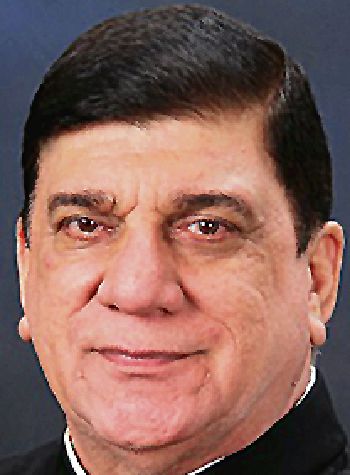

AS euphoric celebrations over Maharashtra state elections lead to a ‘masterstroke’ discourse and headlines, the continuing agony of Manipur has been relegated again. A brief mention of rushing an additional 10,000 CAPF (Central Armed Police Forces) soldiers towards addressing the spiralling Manipuri violence seemingly satisfies the national consciousness. Official figures peg the death toll at about 258, with about a lakh displaced. The substantially higher unofficial figures are automatically pooh-poohed. News coming out of the troubled state is patchy, if any. The complete breakdown of Manipur is a mere footnote in news.
Manipur is a microcosm of India with religio-ethnic diversities, polarised assertions and a deeply contested history that tests the ruling dispensation’s ability to manage the constitutionally aspired unity in diversity. Manipur hosts an amalgamation of Hindus (Vaishnavite Meitei), Christians (Kuki-Zo, Nagas), Muslims (Pangals), Buddhists and tribals and it even had Jews (B’nei Menashe) once upon a time.
Therefore, the erstwhile Kangleipak state (Meitei-ruled Manipuri state) has always had to deal with underlying disaffection among its non-Meitei populace, especially in the hills dominated by Kukis and Nagas. But a certain geographical arrangement and understanding of respecting the local turfs and sensibilities of the various diversities ensured a semblance of normalcy.
In a way, Manipur mirrors the challenges that had beset the newly independent India. It, too, had required the celebration of the commonality of differences as opposed to insisting on the homogeneity of the ‘land of the pure’ or Pakistan. The foundational and constitutional ‘idea of India’ was a direct contrast to the majoritarian ‘idea of Pakistan’as India was fundamentally predicated on inclusivity, secularism and a deliberate accommodation of ‘others’.
Therefore, the ‘idea of India’ always beseeched a large-hearted outreach, protection and affirmation of those whose voice could get naturally diluted in a democratic majority. Ultimately, as numbers matter in a democratic contest, those with lower numbers (read minorities) could get lost. It is this imagined vulnerability of the minorities that led to societal dissonance in regions with higher numbers of minority denominations, like Jammu and Kashmir, Punjab or the Northeast states.
The integration of many of these regions, such as Jammu and Kashmir’s accession to India in 1948, or the Maharaja of Manipur’s signing of the merger agreement in 1949, were by themselves complicated events. Obviously, the forces inimical to India fanned the situational dissonance towards secessionism. It had taken Delhi to course-correct many of its missteps and admit to some excesses whilst signing the peace accords in places like Punjab and Mizoram to trigger the end of insurgent movements. Finally, the ‘Idea of India’ had triumphed by convincing the restive diversities, especially minorities, on the genuineness of Delhi in honouring the foundational spirit of unity in diversity.
Sadly, along with Jammu and Kashmir, Manipur has the dubious distinction of facing the longest continuing insurgency and the maximum number of insurgent groups. Groups like the People’s Liberation Army of Manipur (PLA), People’s Revolutionary Party of Kangleipak and Kangleipak Communist Party represent the societal grouping in the state. Other prominent insurgent groups include Naga groups like the National Socialist Council of Nagaland-Isak-Muivah and National Socialist Council of Nagaland-Khaplang as also the Kuki National Army representing the Kuki ethnicity. These groups have separate, specific, and, often, conflicting agendas that seek to protect their respective turfs and arrangements.
These armed groups could either be pursuing purely secessionist movements, such as the PLA, or protectionist agendas to defend their communities from seceding space in the delicate arrangement from usurpation or diminishment. Many groups have fought violently in the past, like the Kuki forces against the Naga groups, or, like now, the Meitei multitude against the Kukis.
Delhi always had a difficult task in addressing each group and challenge uniquely, without resorting to blanket narratives or presumptions. Therefore, while it is relatively peaceful in the once-troubled places like Nagaland, Mizoram and Assam, the divergence of competing interests in the Manipuri cauldron have failed to end the insurgent movements therein. Although till about 2022, the broadly respected arrangement of various groups ensured relative peace, but not completely. Delhi had to tiptoe around the armed aspirations to not be seen as favouring any group or community.
The local arrangement among the Manipuri divide was given to a sudden fracture, with the local courts suggesting affirmative action that seemed to suit one group over the other perceptively. This move, coincidentally, fitted well with the thrust of majoritarian politics that had entered the region and spurred the ruling dispensation in Delhi into power even in Imphal for the first time in 2017. The fact that this winning partisan thought had successfully conflated religion with nationalism, it axiomatically led to ‘othering’ or aspersions of ‘anti-national’ on to communities that did not fit the formula.
Dangerously, the perception gained credence that Delhi had made a choice among the restive groups that threatened the traditional set piece of local arrangement . The supporting rhetoric was typically one-sided, with murmurs of one side having foreign support, gunrunning, smuggling, territorial denialism and even aspirations of a ‘Christian state’. It didn’t help matters that the actions of the law and order agencies also seemed to favour one side. The absence of the the Prime Minister’s visit despite the scale of tensions and bloodshed only deepened the distrust amongst the proverbial ‘others’ in the conflict.
The new narrative may have electorally benefited the ruling dispensation in the region, but it has also brutally polarised the communities and allies, like the regional National People’s Party, had no choice but to throw in the towel. It is true that conflict-ridden regions like Jammu and Kashmir and Manipur have very little impact on national government formation, with just three seats for the former and two for the strife-torn state. However, these regions with substantial number of minorities or ‘others’ test the sincerity and commitment of the ruling government to the constitutional morality of unity in diversity.
The test is crucial for validating the country’s second-strike capability

The Indian Navy carried out the test firing of the 3,500 Km K-4 ballistic missile from the newly-inducted nuclear submarine INS Arighaat on Wednesday.
According to Defence sources, the test results are being analysed, after which the officials concerned would be briefing the top military and political leadership.
The test is crucial for validating the country’s second-strike capability.
The Indian Navy had inducted the submarine in August in the Vishakhapatnam-based Ship Building Centre.
The sources said that prior to the full-range test of the missile, the DRDO had carried out extensive trials of the launch of the missile to be fired from underwater platforms.
The Indian Navy is now planning to carry out more tests of the missile system.
The Navy has two nuclear submarines with the capability to fire ballistic missiles, including the INS Arihant and the Arighaat.The third boat has also been launched and is expected to be inducted next year.
Experts scrutinise Trudeau’s ‘damage control’ immigration cuts fix

Perched on a leather armchair, speaking directly to viewers, Canadian Prime Minister Justin Trudeau recently explained his government’s new plan to reduce immigration by roughly 20 per cent.
In two videos — one in English and one in French — he outlined the broad strokes of Canadian immigration policy.
The videos are undoubtedly damage control. Trudeau faces decreasing public support for his government’s immigration policy, calls to resign as party leader, and a federal election that the Liberals are on track to lose.
Since the early 2000s, the Canadian public maintained a largely positive view on immigration. However, public opinion has recently shifted. Even though Canadians’ primary concerns remain the economy, housing and health care, when asked about immigration, a clear majority now say there is too much immigration.
The exact cause of this shift remains unclear, but as demonstrated by Europe and the United States, we face potentially serious societal consequences.
As educators focused on immigration, we find Trudeau’s clear communication in the videos impressive. Immigration policy can be complex to communicate, and public attitudes are often based on inaccurate perceptions. Yet, parts of his message shift blame in troubling ways. By attempting to control the narrative with a simple story, Trudeau paints an incomplete picture and perpetuates misleading narratives about Canada’s immigrant selection, higher education and asylum systems.
Increasingly permanent “temporary” residents
In 2022 and 2023, Canada saw the highest annual population growth rates since 1957. While migration has consistently driven Canada’s population growth since 1999, the growth during these two years was uniquely driven by temporary residents, such as migrant workers and international students.
Temporary residents feature prominently in the video, with Trudeau claiming that “most return home” and have “never been a part of the long-term immigration plan”.
However, since the late 1990s, both Liberal and Conservative governments increasingly relied on the “rapid expansion” of two-step immigration — that is, bringing in temporary students and workers, then selecting some already in Canada for permanent status.
In other words, many temporary residents do stay. In fact, since the mid-2010s, the majority of permanent residents coming through economic selection streams were two-step immigrants. This rose to 78 per cent in 2021 as the Covid -19 pandemic shut down much international travel.
That same year, then Minister of Immigration, Refugees and Citizenship, Marco Mendicino, said that Canada’s “message to international students and graduates is simple: we don’t just want you to study here, we want you to stay here”.
Today, the federal government’s official website for prospective international students still states: “Many international students and their families have made Canada their home and become citizens. You could too!”
The active recruitment of both international students and workers is also at odds with what some call scapegoating by politicians in both the government and opposition.
Since mid-2023, temporary residents — and international students in particular — have been repeatedly and explicitly linked to Canada’s housing affordability crisis.
Although Canada is decreasing its temporary resident population through capping study permits and restricting work permits, two-step immigration remains a key part of Canada’s permanent residency selection system. Many temporary residents understandably expect to remain in Canada.
Blaming higher education
Trudeau also claims that “far too many colleges and universities used international students to raise their bottom line…because they could charge these students tens of thousands of dollars more for the same degree”.
Yes, many schools welcomed many international students. And yes, they unquestionably benefit from higher international student tuition fees, raising deeply problematic ethical issues.
However, schools are not implicated equally. Recent international student growth was disproportionately concentrated in a handful of institutions. And one root problem is a much larger issue: declining public funding for higher education, across political parties, since the 1970s.
Trudeau also fails to mention Canada’s 2014-19 and 2019-24 federal International Education Strategies, both of which stressed international students’ economic contributions.
Given the current precarity of Canadian public higher education, now is the time to call for more resources and defend its value — not point fingers as a deflection technique.
Glossing over deportation
Finally, Trudeau tells viewers that “some temporary residents may turn to our asylum system when their visa expires as a shortcut to stay in Canada”, but “if their claim fails, they’ll be sent home”.
This sounds straightforward. But it masks a complex concern: A large number of temporary residents were encouraged to choose Canada, asked to make significant sacrifices and told they could stay.
Many now have no legal path to do so. It is no surprise that some, desperate to remain where they have built lives and community, may turn to seeking asylum. Those who do not, or whose claims are rejected, may become undocumented — living increasingly precarious lives.
In May, Trudeau called for a pathway to regularize undocumented migrants’ status. By August, the government said it has no plans to do so due to a lack of public support. Linking asylum claims to fraud risks undermining Canada’s humanitarian values at a time of decreased public trust in asylum claimants.
Simplicity can illuminate or obscure
Trudeau’s videos outline a quick fix to what he appears to suggest are minor policy mistakes. But simplicity can obscure as much as it illuminates. Temporary migration has been a longstanding pathway to permanent residence and citizenship.
Public schools are not easy villains. Failed asylum claims are not ordinary bureaucratic decision-making. These policies are complex, as are the consequences for millions of people.
Ultimately, the new immigration plan may not last long. If elected, Conservative leader Pierre Poilievre has made vague promises to link population growth to the “availability of jobs, homes, and health care” — though what this actually means is unclear. For now, Trudeau’s goal appears to be to prevent public attitudes on immigration from fracturing further and preserve his legacy.
Yet this does not excuse the federal government for shifting the blame. Trudeau’s strongest critique is reserved for “really bad actors who outright exploit people” and “target vulnerable immigrants with promises of jobs, diplomas and easy pathways to citizenship — promises that would never come true”. Is he describing his own government?
Chinese spokesperson Sr Col Wu Qian said Defence Minister Rajnath Singh and his Chinese counterpart Admiral Dong Jun had a positive and constructive meeting in Vientiane on the sidelines of a regional security conclave

The militaries of China and India are making “great progress” in implementing the disengagement agreement to end over four-year-long standoff in eastern Ladakh, China’s Defence Ministry said Thursday.
“We also look forward to harmonious dance between the Chinese dragon and Indian Elephant with concerted steps,” Defence Ministry spokesperson Sr Col Wu Qian said while addressing the monthly media briefing here.
He said Defence Minister Rajnath Singh and his Chinese counterpart Admiral Dong Jun had a positive and constructive meeting in Vientiane, the capital city of Laos, on the sidelines of a regional security conclave, last week.
The two sides are implementing the settlement reached between the two counties, he said, answering a question on the progress of the execution of the agreement reached between the two countries last month to end the standoff in eastern Ladakh.
“Now, we are making great progress,” he said.
The two ministers agreed to implement the important consensus reached between the top leaders and promote stable relations between the two countries, the spokesman said.
Wu said the two militaries should strictly abide by the recent common understandings reached by the two sides to de-escalate tensions at the border areas, make efforts to bring down the tensions and focus on enhancing mutual trust and exchanges between the two countries.
“We hope the two sides can seize the opportunity and build new momentum to make new progress in the military-to-military relations,” he said.
